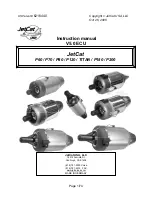
Fuel System
34
62 690 01 Rev. J
KohlerEngines.com
13. Turn old bushing upside down and use it as a driver
to carefully press or tap new bushing into carburetor
body until it bottoms. Check that choke lever pivots
freely without restriction or binding.
14. Install new return spring onto new choke shaft, so
outboard leg of spring is behind formed stop on end
of choke shaft.
Make sure it stays in this location during following
step.
15. Slide choke shaft and spring into carburetor. Pivot
(preload) shaft 3/4 turn counterclockwise with inner
leg of spring against formed stop within choke lever
as originally assembled. Outer leg of spring must still
be behind formed stop of choke shaft.
16. Place a drop of Loctite
®
222MS™ on threads of each
new screw. Position and install new choke plate to
flat side of choke shaft. Start screws. Close choke
and check plate alignment within carburetor throat,
then tighten screws securely. Do not overtighten.
17. Check for proper operation and free movement of
parts. Install new cap.
18. Clean carburetor body, main jets, vent ports, seats,
etc., using a good commercially available carburetor
solvent. Keep away from plastic or rubber parts if
non-compatible. Use clean, dry compressed air to
blow out internal channels and ports. Do not use
metal tools or wire to clean orifices and jets. Inspect
and thoroughly check carburetor for cracks, wear, or
damage. Inspect fuel inlet seat for wear or damage.
Check spring loaded choke plate to make sure it
moves freely on shaft.
19. Install main nozzles into towers of carburetor body.
End of main nozzles with 2 raised shoulders should
be out/down (adjacent to main jets). Make sure
nozzles are completely bottomed. Carefully install
main jets into towers of carburetor body on
appropriate side, as identified when removal was
performed.
20. Make sure O-ring near bottom of each slow jet is
new, or in good condition. Align and insert slow jets
into top of carburetor.
21. Install large flat retaining washer and secure with
mounting screw, attaching ground lead if originally
secured by screw.
22. Install new idle speed (RPM) adjustment screw and
spring onto carburetor. Thread in until 3 or 4 threads
are exposed, as an initial adjustment.
23. Attach inlet needle to plastic tang of float with wire
clip. Formed 90° lip should point up, with needle
valve hanging down.
24. Install float and inlet needle down into seat and
carburetor body. Install new pivot pin through float
hinge and secure with new retaining screw.
25. Hold carburetor body so float assembly hangs
vertically and rests lightly against fuel inlet needle.
Inlet needle should be fully seated but center pin of
needle (on retainer clip end) should not be
depressed. Check float height adjustment.
Be sure to measure from casting surface, not rubber
gasket, if still attached.
26. Correct float height setting is 17 mm (0.669 in.)
± 1.5 mm (0.059 in.), measured from float bottom to
body of carburetor. Replace float if height is different
than specified. DO NOT attempt to adjust by
bending float tab.
27. When proper float height is obtained, carefully
reinstall fuel bowl onto carburetor, using new
O-rings. Secure with original screws. Torque screws
to 2.5 N·m (22 in. lb.) ± 0.3 N·m (3 in. lb.).
28. Set idle mixture screws at midpoint of available
adjustment as a preliminary setting.
29. Use new mounting gaskets for air cleaner and
carburetor. Reinstall carburetor and disassembled
components following Reassembly procedures.
30. Reconnect spark plug leads and negative battery
cable. Start engine and perform Low Idle Speed
Adjustment and Low Idle Fuel Needle(s) settings.
HIGH ALTITUDE OPERATION
This engine may require a high altitude carburetor
kit to ensure correct engine operation at altitudes
above 1219 meters (4000 ft.). To obtain high
altitude kit information or to find a Kohler
authorized dealer visit KohlerEngines.com or call
1-800-544-2444 (U.S. and Canada).
This engine should be operated in its original
configuration below 1219 meters (4000 ft.) as damage
may occur if high altitude carburetor kit is installed and
operated below 1219 meters (4000 ft.).
















































